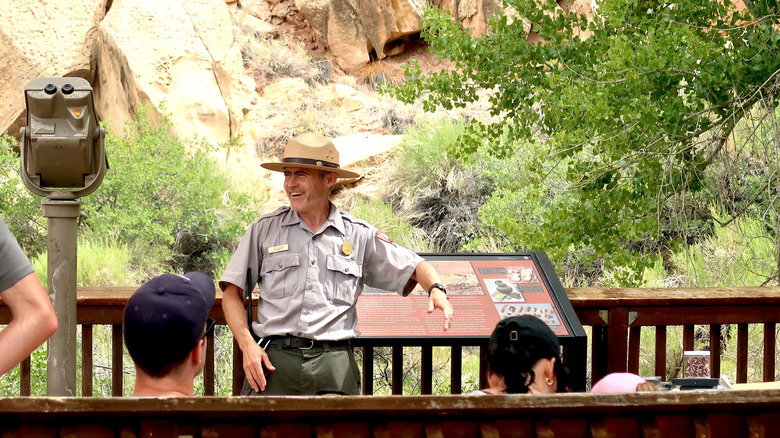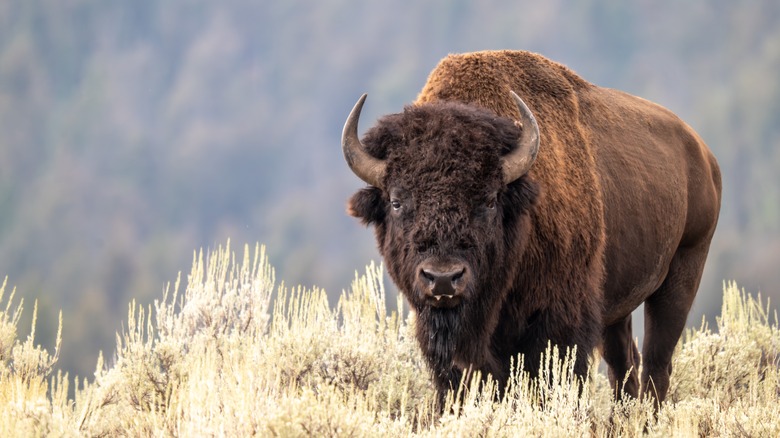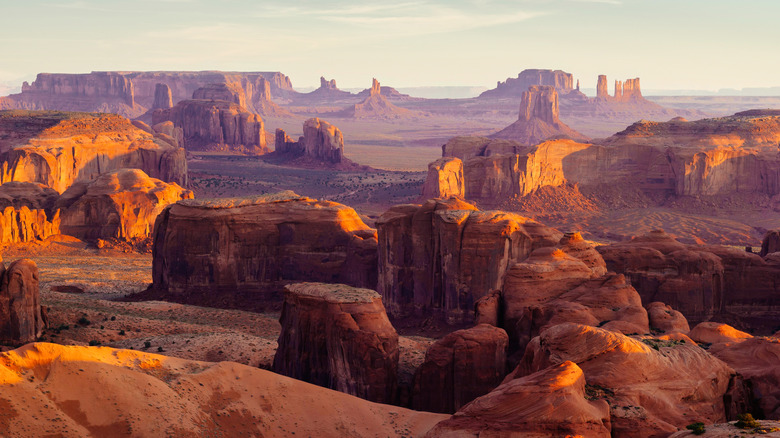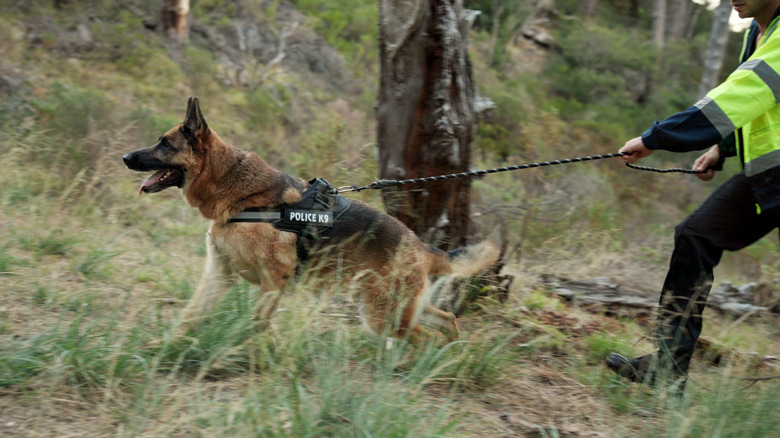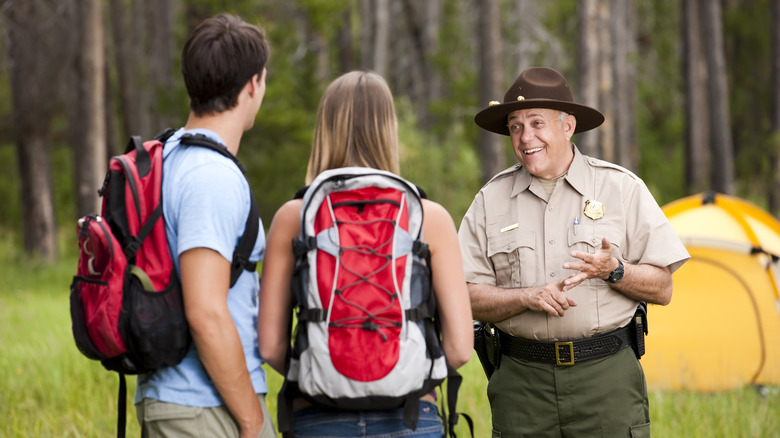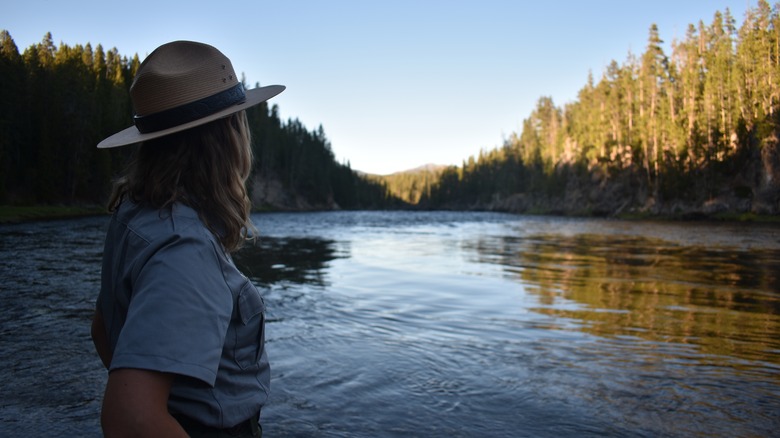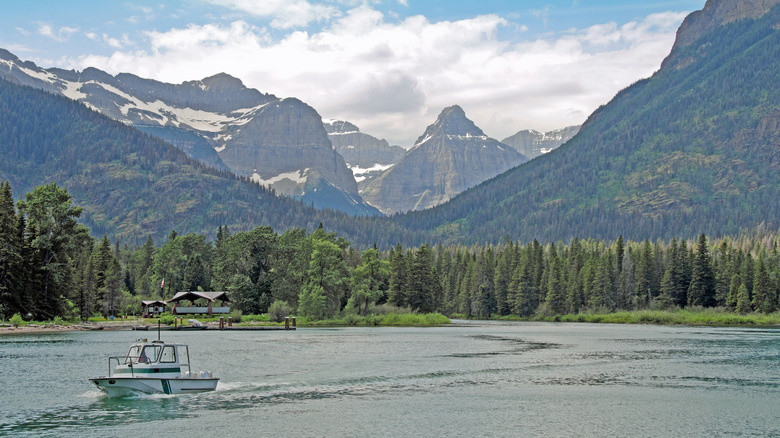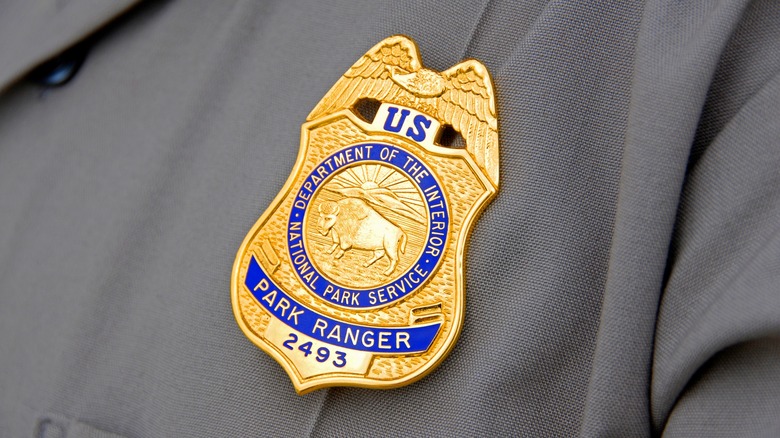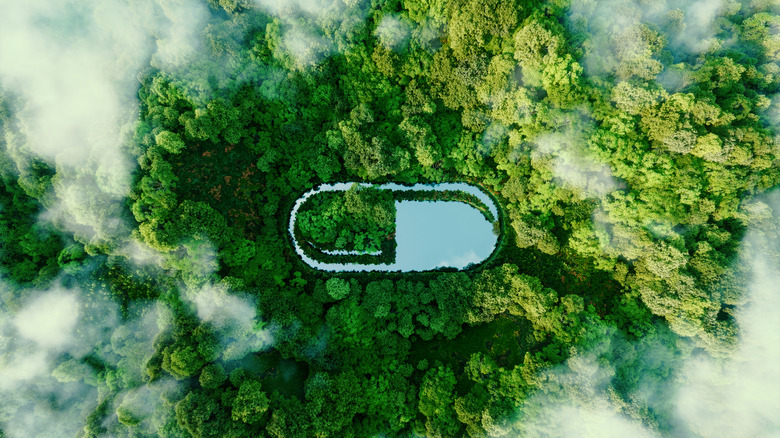The Dangerous Dark Side Of Working As A National Park Service Ranger
There's a mystique and genuine romanticism about calling America's most beautiful scenery your office. National Park Service (NPS) rangers spend their days interacting with eager explorers and taking care of the nation's most beautiful landscapes. The NPS' commitment to the tenets of "leave no trace" makes their mission one of tremendous importance. Rangers must protect the wilderness and its balanced ecosystem while also catering to the needs and questions of people frequenting the parks.
With more than 400 parks across the country (and 63 of which are designated national parks), park rangers certainly have their work cut out for them. The park sites that the service cares for cover a total land area of over 85 million acres. With new federal layoffs impacting ranger numbers, those who remain have even greater responsibilities when it comes to protecting and serving guests and maintaining good stewardship of the land.
Indeed, while life as a park ranger can be exciting and deeply rewarding, the career certainly isn't for everyone. There are plenty of hidden dangers that come with the territory. Numerous darker sides of the job might come as a surprise to even those who frequently spend time in America's national park facilities.
Unpredictable wildlife encounters
One of the most obvious dangers that park rangers encounter on a routine basis involves the wildlife found in these natural habitats. National parks in America feature a similar prioritization of the habitat upon which the landscape is built. NPS employees make it their mission to care for the environment so that it can sustain the wildlife that calls the area home. The park service is a potent outlet for advice when it comes to dealing with wildlife encounters, too. However, it should be noted that numerous tips from the NPS involve keeping your distance and acting in ways that won't disturb the environment. This suggests that there's likely a history of negative visitor interactions with animals across the national park landscape.
When visitors come face to face with bison, bears, or agile predators like panthers and wolves, rangers will frequently be involved in efforts to save these people. An angry animal can spell disaster at the best of times, and so every incident brings about the potential for injury or even the loss of life. Beyond rescue operations, park rangers themselves encounter animals regularly as they perform maintenance tasks. The National Park Service isn't shy about the dangers of animal encounters. Interfering in the routine business of just about any animal can bring about unpredictable behavior, sometimes involving aggression.
Treacherous terrain means increased injury risk at all times
Park rangers patrol the roadways that carve their way through national park lands and the off-trail forests, seascapes, and backcountry wilderness (demanding a few crucial wilderness exploration skills). The office that rangers commute to on a daily basis is one of truly majestic beauty, but that awe-inspiring backdrop can often come at a price. To patrol landscapes that haven't been reformed to support human habitation, NPS rangers will often need to stay on their toes. It's not just predator encounters that can introduce dangerous circumstances into the daily grind of a ranger.
The landscape itself can be immensely treacherous. There's a certain element of physicality that rangers have to account for as they go about their daily tasks. One ranger might spend most of their day bobbing around at sea, while caring for the marine life along a coastal shoreline. Another hikes up and down mountain peaks to keep visitors from getting lost on a particularly difficult route.
In much the same way that professional athletes put their bodies on the line every day, NPS rangers are expected to navigate a frequently demanding working environment. These public servants may sometimes enjoy a bit of downtime sitting in a ranger station or managing a campsite. But park rangers are often mobile, traversing the often-difficult terrain of the site they call home.
Dangerous search and rescue missions
National Park Service rangers spend a lot of time speaking with hikers and maintaining the environment of their park. But simple tasks and casual conversations aren't the only elements these federal employees busy themselves with. According to ColumbusParkRentals.com, it's estimated that roughly 1,000 people go missing in national park locations annually. Smokymountains.com analyzed over 100 news reports to understand this occurrence. It discovered that hikers wandering off an established trail is the leading reason they go missing. Additionally, only 35% returned to civilization on their own; search teams rescued the rest.
Almost by definition, park rangers put themselves in harm's way every time they go out in search of a lost hiker or any other park visitor, a task that rangers are performing at a growing rate. Extreme heat in many parks is making search efforts even more dangerous, too. In truth, it's impossible to fully prepare for what you might find when you leave the trail behind. Inclement weather and lengthy searches that extend past nighttime can easily throw additional complications into the mix, beyond the already fraught conditions. Not all search and rescue efforts yield happy endings, either. This introduces significant levels of stress that only amplify the risks undertaken by park rangers who put themselves on the line for others.
Careless or complicated visitor encounters
Rangers spend plenty of time engaging with campers and hikers. They talk to people out of curiosity and cordiality to provide key information to help visitors make the most of their experience, and to identify potential problem areas that may arise. Rangers regularly ask preventative questions about visitors' hiking plans as a means to get ahead of potentially dangerous circumstances, for instance. Perhaps you're not an experienced hiker, but are unconsciously planning to tackle one of the most challenging national park hikes in America. Casual conversations help rangers get ahead of potential danger that visitors may be exposed to unknowingly.
A lack of knowledge about proper wildlife etiquette is another routine feature of park service rangers' encounters with visitors. From keeping campsites safe from visits by predators looking for unsecured food to dealing with guests who think they can pet seemingly docile animals, careless visitor encounters are a major problem. It's not just those who are blissfully unaware of what their actions can bring about, however, that rangers need to worry about.
In recent years, there's been an uptick in the number of homeless people, drug and alcohol dependent individuals, and those with mental health issues sheltering themselves away in national parks. For some, getting away from the world brings them much-needed peace and quiet, but unpermitted entry into these kinds of areas places a major burden on rangers. While you're at the park, rangers are tasked with keeping you safe. Knowing that these people are entering unannounced and with little to support themselves, rangers have an additional duty of protection that is frequently complicated and unstructured.
Many rangers are haunted by accidents and deaths in their parks
Hundreds of millions of visitors enter U.S. national parks on an annual basis. For the most part, these visits are relaxing, rejuvenating, and largely uneventful in the grand scheme of things. The vast majority of visitors come to explore a national park and then return home without incident. But around 240 people die in America's national parks every year. It's not a large percentage of the total visitorship, but each one of those lives is cherished by their friends and family. The loss of any life is a big deal to someone and can upend the everyday for countless others.
One danger that flies under the radar when speaking about deaths in national parks is the mental health of park rangers. When someone dies in a national park, a search and rescue team or a ranger must act to recover the person's remains. Depending on how long a missing hiker or fall victim has gone unfound, things can get decidedly grizzly when they are ultimately located. Park rangers involved in finding people in danger, saving lost travelers, and recovering remains often carry the scars of these experiences with them.
The isolation can be intense
Park rangers spend lots of time in remote areas. Many national parks are far away from urban life, and plenty of rangers work in remote parts of the country that are miles away from their homes and families. Park rangers frequently work in teams as they patrol trails and the park wilderness. However, the isolation from everything a National Park Service employee has grown up around and knows can be stifling.
In addition to working with others who manage the national park landscape, rangers frequently lived together in shared housing arrangements. But living together and becoming friends isn't always naturally synonymous. You'll always have to put in at least a little bit of work to become close with someone you've just met, even when your circumstances make this a bit easier. You can feel loneliness even when surrounded by a large crowd, and park rangers are often susceptible to these complex, negative feelings. Those who don't get along with their coworkers or build relationships early on, especially in smaller parks, can often find themselves dealing with intense isolation. This can dampen the enjoyment of even the extreme highlights of the job.
Violent encounters with visitors; it's a serious issue
Most people who have spent time exploring a national park can't imagine a world in which visitors to these scenic and immensely rewarding landscapes would behave in an aggressive or violent manner. It might be tempting to think that visitors across the board are looking for at least a modicum of peace and quiet as they enter the gates of any national park. Hiking, camping, and even picnicking or going for a swim in a national park's waters are all incredibly relaxing activities. They frequently bring out calm demeanors and friendly behavior. But this isn't always the case.
According to NPR, rangers working in America's national parks are more likely to be assaulted by visitors and intruders than by various groups of law enforcement. This is a result of the unbalanced ratio of the number of visitors and park rangers working in these national landscapes. Visitor numbers have only continued to increase in the decades since that reporting, and park ranger numbers are once again on the decline. This means that the conditions for violence against rangers remain firmly in effect. Unfortunately, these public servants are subjected to physical and verbal abuse on a regular basis, even to this day.
Specialist jobs require all kinds of peculiar hazards at sea
Park ranger Stephanie McCullough wrote about her experiences with the National Park Service working in Alaska's Glacier Bay National Park in The Ranger Desk. McCullough noted that her days would typically begin at 4 a.m. and involve a walk through rainforest trails to the park headquarters. Her job was a particularly dangerous one that required her to hop on a boat to come up alongside cruise ships entering the park's waters. She would then climb aboard these gigantic vessels by transitioning from her boat to a rope ladder lowered down by the cruise ship's crew members. All this was done while the ship remained in motion, with her own captain matching the speed of the incoming vessel to allow a smooth transition.
These intercepts would take place early in the morning, and after a few hours talking with cruise guests about the environment and answering questions they might have, she would return to her boat via the same rope ladder. However, this time, there would be plenty of eager eyes set upon her descent. She pointed out that this boarding procedure had taken place in the park largely without incident for decades. However, this doesn't mean the task didn't come with its own set of significant risks. On one transition, she told the story of an exchange gone wrong. The wake of another vessel passing by sent her boat crashing into the hull of the cruise ship, mere seconds after she was alerted and scrambled back up the ladder, away from a near-certain death.
Florida Everglades-based rangers find and remove Burmese pythons from the swampy wilderness
The Burmese python is an invasive species that entered the Florida Everglades sometime in the 1970s. It's not native to the area, but lax protections built into the trade of exotic animals are thought to have allowed pythons to make this environment their home. The Burmese python can grow to around 20 feet in length and is a significant threat to many other species found within the swampy Southern Florida ecosystem. It's thought that between 1997 and 2012, more than one local rabbit species and native foxes were wiped out in the Everglades (via USGS). Immense reductions in bobcat, raccoon, and other animals' numbers are also of major concern.
Burmese pythons aren't the only exotic, non-native snakes that have been found here, but they are the most prominent and pose the greatest risk. The NPS is actively engaged in research and practices designed to remove pythons and other invasive snake species from the Everglades. Naturally, hunting predatory snakes in a habitat they have learned to thrive in isn't particularly safe work!
Apprehending poachers
Hunting is allowed in some national parks and national park areas, but there's a careful balance that must be struck by those hoping to engage in the practice. Hunting and fishing are done legally by those who have engaged with federal and local authorities to procure the correct licenses. Generally, there will be limits to the number of animals you are allowed to catch or kill, and other restrictions are often placed upon juvenile creatures to maintain a healthy population balance.
Poaching is the act of hunting or fishing without legal authorization. It's usually connected with a focus on protected species or an effort to traffic in illegally obtained animal parts (think ivory tusks and shark fins). Some poachers carelessly, unknowingly, or unintentionally fish in areas that are unauthorized or shoot animals protected by special regulations.
But national parks are no strangers to intentional, illicit hunting activities. Malignant poachers are active in national parks across the United States, and they engage in these practices specifically because park rangers simply don't have the numbers required in their ranks to deal with this problem in full. Intentional criminal activity of this nature is made far more complicated by the fact that poachers tend to carry weapons with them by default. A criminal caught in the woods is certainly an unpredictable actor. Throw a rifle or hunting knife into the picture, and they become even more dangerous to deal with.
The mental stress of public perception
People sometimes look down on park rangers as non-serious federal employees. This may be as a result of their attire or the distinct lack of a "law enforcement vibe" surrounding the job. Yet rangers are there to keep people safe and perform a crucial law enforcement duty alongside some of their other responsibilities. The disconnect in the way that the public sees these federal agents can be mentally draining for some. The level of disrespect is frequently baked into interactions between visitors who think they can do whatever they want and the rangers who are there to keep them safe and support their enjoyment.
There's also an element of animosity that can come into play under certain circumstances. Locals who frequent a national park can sometimes be disparaging of NPS employees who are doing their best to protect the environment. Rangers sometimes point out that they are insulted both on the job and outside of the parks they serve. They must act to stop illicit behaviors when they encounter them, sometimes provoking mockery from park regulars and locals in response. This can be a lot to take for rangers who are already stressed by the rigors of the job, both mentally and physically.
Stumbling onto the scene of illicit drug production and transit
Because law enforcement staff at national parks are spread so thin, many people who engage in a laundry list of illicit activities have been known to use federal landscapes as a backdrop for their misanthropic adventures. One such endeavor is the creation and trafficking of illegal drugs. Drugs of all sorts are transported through national parks because traffickers know the federal agents seeking to apprehend them are in short supply. Parks act as a home base in many instances for these kinds of threatening individuals.
More to the point, those engaged in drug production and movement are frequently working with other criminal enterprises rather than as a solo venture. Whether through a cartel or gang affiliation or less cogent business alliances, there's often a lot riding on any particular batch or transaction. Because the illegal drug market features so much violence and additional wrinkles of illegality, some participants may not hesitate to open fire on a park ranger who stumbles onto the scene or behave in any number of other violent and unpredictable ways.
